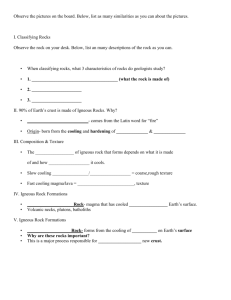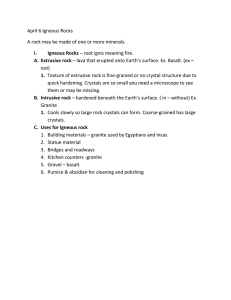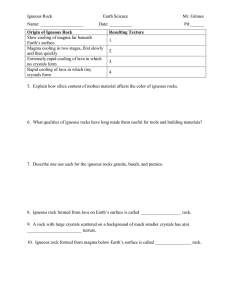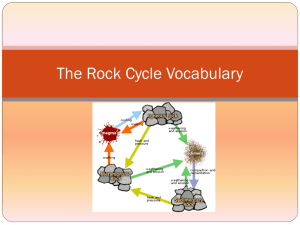Igneous Rock - Mrs. Dawson's Classroom
advertisement
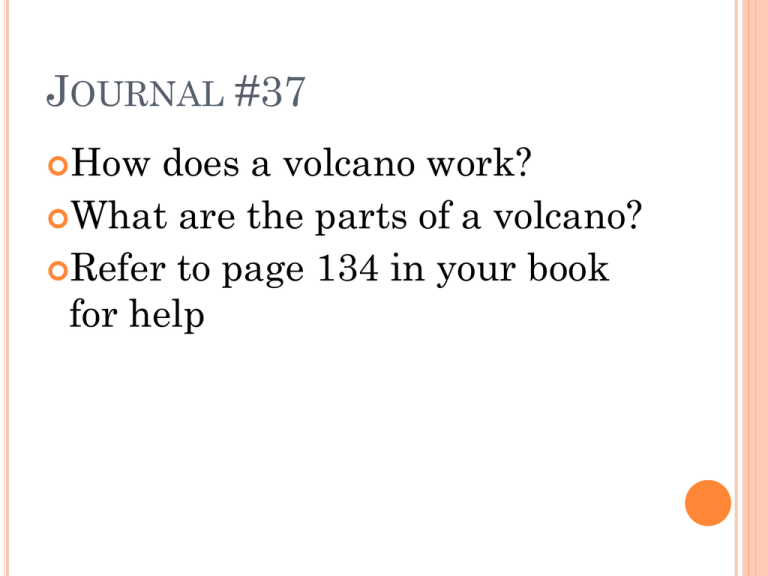
JOURNAL #37 How does a volcano work? What are the parts of a volcano? Refer to page 134 in your book for help TODAY WE WILL DESCRIBE 3 FACTORS THAT AFFECT WHETHER ROCK MELTS AND CLASSIFY IGNEOUS ROCKS ACCORDING TO THEIR COMPOSITION AND TEXTURE IGNEOUS ROCK When magma cools and hardens, it forms Igneous Rock. Because minerals crystallize as igneous rock forms from magma, most igneous rock can be identified as crystalline. Magma form when rock melts. IGNEOUS ROCK The 3 factors that affect whether rock melts include: Temperature Pressure Pressure of fluids in the rock Temperature Rock melts when the temperature of the rock increases to above the melting point of minerals in the rock. Pressure Rock melts when pressure is removed from rock that is hotter than its melting point. Pressure of fluids in the rock The addition of fluids generally decreases the melting point of certain minerals in the rock, which can cause those minerals to melt. PARTIAL MELTING Different minerals have different melting points, and minerals that have lower melting points are the first mineral to melt. The process by which different minerals in rock melt at different temperatures is called partial melting. FRACTIONAL CRYSTALLIZATION Opposite of partial melting Chemicals in magma combine to form minerals, and each mineral has a different freezing point. As minerals freeze (crystallize) at different times, those chemicals are removed from the magma. The removal of different minerals as magma cools is called fractional crystallization. TEXTURES OF IGNEOUS ROCKS Igneous rocks are classified according to where magma cools and hardens Intrusive Igneous Rock- rock formed from the cooling and solidification of magma beneath Earth’s surface Extrusive Igneous Rock- rock that forms from the cooling and solidification of lava at the Earth’s surface TEXTURES OF IGNEOUS ROCKS The texture of igneous rock is determined by the size of the crystals in the rock. The size of the crystals is determined by the cooling rate of the magma. Examples: Coarse-Grained Igneous Rock- large crystals Fine-Grained Igneous Rock- small crystals Granite Basalt, Rhyolite Porphyritic Igneous Rock- mixture of large and small crystals Obsidian, Pumic COMPOSITION OF IGNEOUS ROCKS The mineral composition of an igneous rock is determined by the chemical composition Felsic Rock- describes magma or igneous rock that is rich in felspars and silica and that is generally light in color. Examples: granite, pumice Mafic Rock- describes magma or igneous rock that is rich in magnesium and iron and is generally darker in color. Examples: Basalt Intermediate Rock- lower proportions of silica than rock sin the felsic familyand higher proportions of silica than rock sin the mafic family Examples Diorite and Andesite EXTRUSIVE IGNEOUS ROCK STRUCTURES Igneous rock masses that form on the Earth’s surface are called Extrusions. A volcano is a vent through which magma, gases or volcanic ash is expelled. When a volcanic eruption stops, the magma in the vent may cool to form rock. The soft parts of the volcano are eroded by wind and water. The solidified central vent is called a volcanic neck. YOU’RE ASSIGNMENT: Work in PAIRS to complete Igneous Rock Review Use notes and pages 129-134 in your book


